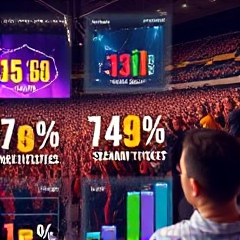Review of the book "Marketing in the sports industry. For those who are in the game" by Andrey Malygin
His approach is not a dry retelling of a textbook, but a live work with examples.
The author is not afraid of harsh formulations and briskly walks on the rake of domestic sports marketing, forcing the reader to either frown or nod in understanding.
Malygin emphasizes at every step: sports marketing is not about abstract schemes, but about the ability to hear and engage the audience, even at the cost of breaking established templates.
The book challenges: you're either in the game, or you're watching from behind the fence, and illusions are not tolerated here.
Key Concepts and Their Analysis

From the very beginning, Andrey Malygin throws the reader into the thick of sports marketing without unnecessary greetings, where the agenda is not abstract theories, but a fierce struggle for the attention of the fan, whose preferences change at the speed of a goal in the last seconds of the match.
The author is not limited to a banal description of the portrait of the target audience - he skillfully reveals the underlying details of how a football club from the third league increased sales of seasonal tickets over three seasons due to targeted work with local fan communities.
In analyzing branding, Malygin does not repeat textbook clichés, but with his characteristic irony, he examines the case of a hockey team that:
- changed the colors of their uniform
- lost loyal viewers
Here is the price of a mistake in practice.
Delving into the details of competitive analysis, the author provides fresh data, showing:
- the sports services market is growing by almost 6% per year
And that means every wrong step is a blow to the budget.
Malygin does not soar into the heavens of abstractions - his recommendations are imbued with pragmatism, and behind each thesis are real numbers, living emotions, and a sober view of the industry, where there is no place for rose-colored glasses.
Who is the book for
The book is not one of those cases when they write "for a wide range of readers" on the cover - the target audience is extremely clear:
- People whose daily routine is connected with arenas
- Tickets
- Merchandise
- Headaches about new communication channels
Club managers, marketers, PR specialists, sales managers - these are the people who, in the author's opinion, will really benefit from reading these pages. Those who are just starting out in the industry will also gain insight:
- No superficial advice
- A detailed explanation of why understanding the psychology of stadium fans and the nuances of sponsorship agreements is essential
For students of specialized universities who dream of a career not in theory, but in real clubs, this publication can replace a couple of semesters of practice:
- Practical tools and fresh case studies are packed tightly here
However, it will be challenging for a casual fan who stumbles upon the book:
- Too much professional slang
- Specific numbers and tough assessments
The author clearly counts on those who are in the know and don't look for easy ways.
About the author and his significance in marketing

To be fair, Andrey Malygin's name on the cover is not just a decoration for the sake of solidity. The author has behind him not an abstract pedagogical experience or theoretical knowledge, but decades of real battles in the sports events market, contracts with major clubs, and the launch of large-scale projects.
- Implementation of CRM-systems for leading hockey teams
- Managing advertising activations at the federal level
- A person who knows the inside story: he has repeatedly "warmed up" the kitchen.
- The ability to pinpoint business pain points: the text feels the tension accumulated during numerous negotiations, failures, and victories.
- Specificity in statements: there is no hint of detachment or academic dryness.
Each piece of advice is based on real experience: the kind that is not ashamed to test in practice and discuss in the corridors of specialized conferences.
The place of the book in modern marketing literature
Amidst a series of similar works where marketing is presented with a claim to universality and vague "insights", this publication stands out with its sharp practicality and clear address: it is as if written for those who have already faced real industry challenges and are not ready to settle for a banal retelling of Western cases.
Malygin's work does not get lost in endless lists of "best practices", but drives stakes into specific Russian realities:
- implementation statistics
- figures on the return of fans to stadiums
- analysis of failed campaigns at the 2018 World Cup
— all this turns the book into a tool, not just a pretty wrapper. Compared to the overhyped foreign bestsellers, where there's a lot of water and minimal applicable specifics, here the reader gets a working set — not outdated dogmas, but a dynamically updated guide for those in the daily race for loyalty and numbers.
Such a place on the shelf is not just for show, but one of those you return to in time crunch and controversial situations to find a solution, not an excuse.
| Criteria | Edition | Foreign bestsellers |
|---|---|---|
| Practical application | Yes | No |
| Specific examples | Yes | No |
| Relevance | High | Low |
Relevance of the publication at the moment

Now, when the sports sphere in Russia is balancing on the edge of change, and the market is experiencing a storm of digitalization and commercial boom, this work hits the mark - not as another reading material "about success", but as a live response to the request of the time.
- The number of fans at stadiums has grown over the past three years.
- Club budgets for digital have more than doubled.
- In conditions when old tricks worked only halfway, and foreign methods are stalling on Russian soil, here the reader finds not only fresh analytics, but also recipes born in the midst of events.
- Such a publication today is not a luxury, but a vital necessity for those who do not want to be left on the sidelines of a rapidly changing industry.
Fundamental Marketing Concepts

If you get rid of all the hype and marketing gloss, this book breaks down to the core concepts that are often spoken about vaguely and without reference to reality:
- Segmentation
- Positioning
- USP
Here, these words come to life. The author doesn't resort to lecturing: if it's about the target audience, it's not about abstract "fans," but, for example, Dynamo's fan sector, where the average age is 24, and who can be engaged through TikTok and Telegram channels.
If it's about a brand, it's not about fragmented slogans, but a step-by-step development of a platform that then underlies all the club's communication, from merchandise to partner integrations.
Reading these pages, you catch yourself thinking: this is the real meat of the industry, not a summary of Western textbooks. You can feel that the author is not so much concerned with academic formulas as with real experience — the kind that allows a club from a regional championship to grow into a media player of federal scale.
Innovative ideas and modern trends
Here, the reader is not only revealed the behind-the-scenes of familiar advertising techniques, but also a fresh look at how audience engagement really works in an era when one meme can fill a stadium.
Malygin is not limited to a standard set of tools: he brings to light TikTok challenges, fan engagement gamification and integrations with eSports, showing how provincial sports clubs enter federal trends, when in a month they increase their social media coverage, and offline events are attended not only by young fans, but also by sponsors interested in a viral effect.
Every idea here is not a theoretical abstraction, but a working tool — be it:
- launching a loyalty system through a mobile app
- developing personal media images of players
which replace impersonal press releases. The author does not flatter the reader: he insists that today the winners are not those who make the loudest statements, but those who can catch digital trends on the fly and instantly integrate them into the club's structure.
The author's approach is fresh and provocative — not just because the described cases actually worked, but because the author's approach itself provokes one to break out of the established and try to outplay the industry's rules.
Applicability of concepts in modern business
If you discard the usual clichés and thoughtfully analyze what's being offered on these pages, it becomes clear: the reader is not being fed a retelling of classical models, but is literally forced to try them on the real landscape, where sports are not just a field or arena, but a huge digital organism. Technology here is not a decorative element, but a driving force; a telling example is the case of implementing push notifications, thanks to which the conversion to ticket purchases skyrocketed during one campaign.
The author, with his characteristic irony, demonstrates how a seemingly banal idea of live broadcasts turns into a catalyst for doubling the subscriber base — and this is not some metropolitan flagship, but a modest club with a budget that is several times lower than its competitors.
The risks and "pitfalls" are described scrupulously and without rose-colored glasses: they don't hide that not every tool takes off, but it's precisely practical applicability — that's the salt that many "smooth" textbooks lack.
Among the analyzed techniques:
- Integration with food delivery services at matches
- Working with micro-influencers
- Launching NFT collections for collectors
All this is not just trendy gimmicks for hype, but really working mechanisms that can be taken and implemented as soon as tomorrow.
| Technique | Effect | Icon |
|---|---|---|
| Integration with delivery services | Increased sales | |
| Working with micro-influencers | Audience growth | |
| Launching NFT collections | Increased interest |
Case studies and examples from real business
One of the main advantages of the book is a large number of real-life examples and practical case studies that illustrate how marketing works in the sports industry. This is not a collection of theories - Malygin relies on specific situations that have occurred with Russian and foreign clubs, federations, leagues and individual athletes.
- Esports as a strategic growth tool. The author analyzes in detail how sports clubs and leagues integrate gaming and esports into their marketing strategy.
- Branding model in practice. The book presents a system of eight brand components (name, story, values, standards, etc.), and each element is accompanied by examples from the work of real clubs - from European football teams to Russian leagues.
- Personal brand of an athlete. The author describes step by step how an athlete's personal marketing is built: from recording sports results to creating an image, maintaining social media and monetization. Both well-known and beginner athletes are used as examples.
Each story is not just a tick in the list, but a detailed analysis with numbers, emotions, mistakes and victories. Here, the reader will not be left in the fog of abstractions: all tools and solutions are shown on real people and brands, so that even a novice can recognize their mistakes and see ways to grow.
Strengths of the publication
The book's applied merits give it particular power: it doesn't just stop at arranging theoretical figures on the board, but offers direct moves for real games.
The reader is literally immersed in the working kitchen:
- Visual schemes for launching advertising campaigns
- Step-by-step analysis of email strategies
- Detailed description of sales funnels
All this is not dusty calculations, but tools that can be taken and applied tomorrow. It's especially valuable that the author is not afraid to go against templates: he debunks common misconceptions, for example, about the "magic" of famous ambassadors — and shows how local projects without big names achieved a threefold increase in coverage per season.
The depth of attention to detail is impressive: each case is provided with specific numbers, graphs, and even examples of letters, which turns reading into a master class, rather than another retelling of banal postulates.
As a result, even an experienced specialist will find fresh solutions and food for thought here, and a novice won't get confused in terms and will immediately get a working arsenal — and this is not just words, but the result of a thoughtful approach, in which you can feel respect for the reader.
Critical Analysis
At first glance, it seems that the reader is faced with another guidebook containing a set of tips from the category “do this, do that”, but if you dig deeper, it becomes clear that the author doesn’t settle for superficial recommendations.
Here’s an example: in the section on digital promotion, one regional club’s team increased sales of seasonal tickets over the course of a year - not thanks to big names, but due to:
- Meticulous analysis of fans,
- Restructuring content plans,
- Implementing automated mailouts.
However, there’s a fly in the ointment - sometimes it feels like the author is more familiar with the experience of large clubs and agencies, while less well-resourced projects are left out of the discussion. What’s also missing is a critical look at the risks:
- For example, one email marketing strategy is presented as a universal solution, although the experience of smaller teams shows that without proper segmentation and testing, you can simply waste the budget.
Nevertheless, it is this very imbalance that sparks interest: the material encourages independent analysis, making you wonder where the boundary lies between universal schemes and unique scenarios for each team.
Tools and techniques for practical use
Moving on to the tools offered to the reader, it becomes clear: there is no room for banal advice in the style of “post it and wait for miracles”. The book discusses specific, step-by-step algorithms — for example, the author does not limit himself to general words about data collection, but demonstrates how one club implemented automated analytics of fan behavior and doubled the return on investment in email campaigns within three months.
However, reading these cases, one gets the feeling that the author is mentally standing on the stands of a top club, and teams without impressive budgets are left out of the game — it would be nice to see more advice for those who count every ruble. The unambiguous praise for mailings looks especially controversial: practice shows that without segmentation and analysis of responses, money can easily leak through your fingers, and in the book, this moment is only superficially mentioned.
Nevertheless, it is this bias towards large players that motivates the reader to independently apply the proposed schemes to their business, look for weaknesses, and not take everything on faith — perhaps this is where the true practical value of the publication lies.
| Factor | Top clubs | Teams with limited budget |
|---|---|---|
| Automated analytics | ||
| Segmentation | ||
| Response analysis | ||
| Investments in email campaigns |
Popularity of this publication

Against the backdrop of criticism of the tools, one cannot help but notice the scale on which the book has been received in the professional community:
- The book has garnered dozens of reviews, which praise its practical focus, clear structure, and usefulness for marketers involved in sports.
- Individual chapters and case studies from the book are mentioned in articles on Sports.ru, in Telegram channels of sports managers, and on educational platforms.
- Chapters from this material have already become required reading on online courses on sports management.
- In marketer communities, links to case studies analyzed by the author regularly appear.
- Representatives of regional clubs note the practical benefits of the solutions presented in the book.
Despite the hype, scepticism is also in the air: there are opinions that the popularity is partially fueled by the lack of quality alternatives in the Russian market. Nevertheless, sales figures, high citation rates, and the author's constant presence in expert discussions speak for themselves — the public has voted with interest, not just with a trend.
Other works by the author
Andrey Malygin is not only the author of the book "Marketing in the Sports Industry", but also one of the few Russian specialists who systematically writes and speaks on the topic of sports marketing.
Among his other projects and works:The book "More than Sport" (co-authored). A publication that explores how sports organizations can build long-term relationships with fans, partners, and the community.
Educational courses and lectures. He lectures on sports marketing at Moscow State University and the Higher School of Economics, conducts open webinars and master classes, and collaborates with platforms like "Netology" and "Skillbox".
Publications in professional media. His articles and interviews regularly appear on Sports.ru, in publications such as "RBC Sport" and "Championship", as well as in business media, where he examines marketing through the lens of managing sports assets.
Thus, the book is not a one-time attempt by the author to "speak out", but part of a broad expert and educational activity. It is backed by experience, involvement in the industry, and a desire to develop a professional community of sports marketing in Russia.
Comparison with other works by the author
If we recall the author's previous works, a striking shift immediately catches the eye: from a dry collection of formulas and indicators, designed more for an audience of university lecturers and desk analysts, Malygin has stepped into a powerful guide for those who face real market challenges every day. His new texts are not just abundantly seasoned with examples from the life of Russian clubs, but literally pulsate with the dynamics of real business processes:
- from the implementation of subscription programs in hockey teams
- to the analysis of failed advertising campaigns, where budgets went down the drain
In comparison with earlier works, where the emphasis was on theory and statistics, the author's current approach is much more focused on practice and solving specific problems — now every piece of advice is accompanied not by an abstract diagram, but by a "live" story of success or failure, which allows the reader not just to understand, but literally experience the scenarios firsthand.
If earlier Malygin's books served more as a reference for an exam, now they have made their way onto the desks of managers and marketers seeking not abstract truths, but working tools capable of bringing tangible profits in the near season.
| Parameter | Early works | New works |
|---|---|---|
| Focus | Theory and statistics | Practice and real examples |
| Target audience | Lecturers and analysts | Managers and marketers |
| Approach | Reference for an exam | Working tools |
Similar literature by other authors
If you try to compare this work with other notable publications on the market, it becomes immediately clear: most competitors are stuck somewhere between a lecture summary and a retelling of Western clichés.
- For example, Natalia Burimskaya's "Sport as Business" is more like a collection of academic theses, where the living fabric of the industry is lost behind a multitude of complex terms — it's like looking at a stadium from a bird's-eye view, but not hearing the roar of the stands or the bounce of the balls.
- At the same time, Western authors like Philip Kotler and Simon Chadwick often operate with global cases and abstract models in their works, forgetting about Russian realities.
- The analyzed publication literally breathes with the current day of domestic sports: there's no room for routine advice here, only schemes, calculations, and even admissions of mistakes tested in practice.
- Against the background of the notorious "step-by-step guides", where the essence is lost behind the dull scheme of "do one, do two", the work under consideration acts as a full-fledged guide for those who prefer to act rather than theorize.
Andrei Malygin's book is a rare and valuable practical work addressed to sports marketing professionals. The author offers a lively, non-academic look at the real challenges of the industry, supporting his theses with specific cases and relevant figures. This publication is an indispensable working tool for marketers, club managers, and anyone who wants to deeply understand and effectively work in the sports industry.
